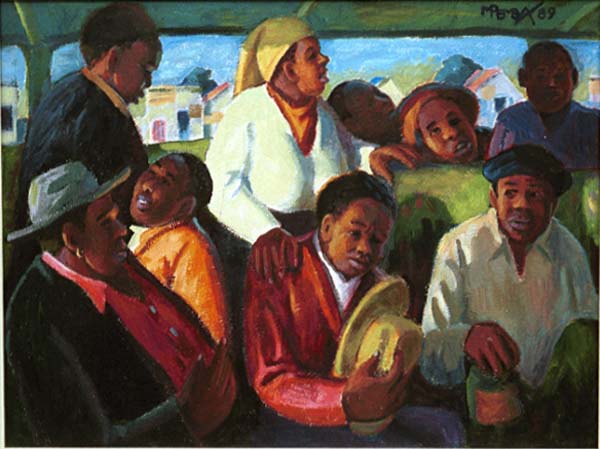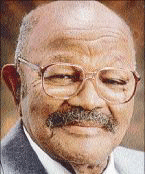Apr 19, 2024
Apr 19, 2024
I have worked in African Township Hospitals since nearly sixteen years. My first encounter with African Township life was at the Mizlikazi Township in Bulawayo, Zimbabwe in the nineties. I was then a Registrar in Orthopaedic Surgery at the Mpilo Central Hospital in Bulawayo. The township use to burst with gaiety especially on weekends. Jazz, dancing and beer use to overflow at every street. People forgot their everyday problems and came together in a stream of enjoyment.. I remember dancing to the strains of Amandamara.
I shifted to Umtata in the former Transkei and later to Mdantsane in the former Ciskei. I still work in Mdantsane and have been enjoying the thrills of a vibrant township life. I have encountered township art on various occasions. There is a school next to the Cecilia Makiwane Hospital, where I work, its walls are painted with such beautiful murals ranging from the school headmaster wearing his felt hat to girls in various festivity dress. I have always wondered who the artist may be.
Apartheid era brought a restriction to inflow of knowledge on world art to such remote townships. But that didn't restrict the art which kept on flowing from their brushes. The art is unique as it didn't have any influences.
One of these is an artist called George Pemba whose works were recognized only at the age of seventy-nine. I came across a painting done by George Pemba at the Ann Bryant Art Gallery, East London, South Africa. It is titled 'Overload' and is Oil on Canvas work. It is a typical depiction of a township scene with people in various emotional states overloaded in a bus. I was struck with the deft brush strokes that brought out such realty that one needs to see the picture again and again and from different angles. It brought in me such happiness being familiar with such daily scenes in townships, where I work.

Pemba's often na'vely styled work focused on the simple lives of poor black people, humbly and sometimes humorously evincing their fundamental humanity, though he also treated themes such as the story of the Xhosa prophetess Nongqawuse of the 19th century.
Black artists such as Gerard Sekoto and George Pemba had less interest in exploring the formal complexities thrown up by European-influenced modernism. Instead they concentrated on depicting their realities and environments in a direct, though forcefully expressionist, manner. George Pemba, by contrast, stayed at home in small-town South Africa (in the township of Motherwell near Port Elizabeth), living into his 90s and patiently continuing to paint despite the lack of public acclaim - although that arrived late in his life, when a new awareness of neglected black art brought artists such as Sekoto and Pemba to renewed prominence.
His subject is the poignant social realism of township life - through what could, superficially, be perceived as a simplistic reflection of life in the New Brighton Township and Eastern Cape surrounds. He painted the harsh story of life in a South African township at the height of Apartheid's oppression.
Many have been inspired by his works, his dreams and his vision for the arts being a healing and expression form for all in Africa to appreciate as a way of being able to be tolerant of all cultures as diverse as their art.
Today, he is synonymous with the arts in Port Elizabeth as seen by those who struggled under the apartheid regimes of our not so distant past.
 Pemba was born in Hills's Kraal, Korsten Village, Port Elizabeth, in 1912. He attended the Van der Kemp Mission Primary School and Paterson Secondary School on a Grey scholarship, which he won, enabling him to receive post primary education.
Pemba was born in Hills's Kraal, Korsten Village, Port Elizabeth, in 1912. He attended the Van der Kemp Mission Primary School and Paterson Secondary School on a Grey scholarship, which he won, enabling him to receive post primary education.
Like most schools for black pupils in South African, neither offered art as a part of its syllabus but as a child he was encouraged by his father to draw and paint, and so began painting murals on the family house and producing portraits from photographs of his father's employers.
He became increasingly involved in resistance politics, joining the African National Congress in 1945 and producing a number of satirical cartoons for the newspaper Isizwe. He struggled to exhibit his work and returned seriously to his painting only in 1965.
Pemba painted a range of subjects: portraits of individuals from a variety of backgrounds, images drawn from Xhosa and Sotho traditions, and landscapes. He is, however, best known for his township scenes.
As a social historian Pemba interpreted the customs and living conditions of township dwellers of the Eastern Cape during apartheid, revealing processes of modernization in which a resilient black culture survives extreme oppression. The paintings, however, were not couched in the socialist realism of revolutionary 20th century propaganda art, but rather in an impressionistic style in keeping with the trends set by Eastern Cape artists such as Dorothy Kay, with whom Pemba painted in the 1950's.
Pemba also executed paintings that reflect an abiding interest in African tradition and its values and customs, particularly as manifested in Xhosa and Sotho dress and ritual. Many are unnamed portraits encapsulating the enduring nobility of African heritage, set apart from ethnographic studies by their intensity and sense of individuality.
Although Pemba was recognized among the black intelligentsia from the 1940's and received honorary degrees from the universities of Fort Hare (1979), Zululand (1986) and Bophutatswana (1986/7), his acceptance into the art establishment was only fully accomplished by the retrospective exhibition and catalogue of his works put together by the staff of the South African National Gallery in 1996, and the publication of a monograph on his works by Sarah Huddleston in the same year.
With Pemba's death the era of the pioneers comes to an end. He blazed a trail through the art establishment in South Africa, laying claim to a place for black artists, but at the same time refusing to compromise his political and moral principles.
George Pemba is the glorious son of Eastern Cape. He was never just a Township Artist. His art which brought the average South African, repressed to a corner on to a liberal expression of form and colors, an art that refuses to be compared till today.
References '
Against All Odds: George Pemba: His Life and Works - Sarah Huddleston
ISBN: 1868420361
Archives of Daily Dispatch
20-Aug-2010
More by : Dr. Amitabh Mitra

|
Hello. My name is Mathias König from Bremen, Germany. My Kids found some Toys witch they dont need. I dont want to waste it.We like to donate it.I think some Boys and Girls in Southafrica can be happy when they get it. Can you please check for some Organisations in South Africa or in your City witch take such a Donate and send me the Adress. Most Organisation want only Money as Donate.I like to give that Toys bevor we kick it into the Trash. We have some Cars,Books,Puzzle and some other stuff. If you have some Question write me. koenigmathias@web.de Have a nice Day. Greetings Mathias König |